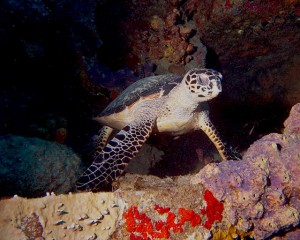I always get a little concerned as we approach the end of the month, but the fact is with all my other commitments, the last week is often the best time for me to be able to carve out a day for diving. (Not that I don’t work the rest of the day to “make up for it”) Anyway, Tuesday’s conditions were nice even though visibility was down a bit. There were two couples on the boat from Quebec; one who was experiencing Key Largo diving for the first time. A different couple whom Hubby was guiding (along with the others) had been trained in lakes and a quarry so this was their first ocean dive. I did my best to find them all some really cool stuff and wasn’t able to come up with anything “big”. However, I usually come up a little earlier than Hubby and it turned out they saw a baby Goliath Grouper after I headed back to the boat. “Baby” in this definition was probably close to 75 or more pounds. The same thing happened on the second dive where they saw a nurse shark. While I would have enjoyed seeing both of those, it’s more important for the visitors to have the extra experience.
The usual array of fish was good, especially on the wreck of the Benwood where we saw three or four large schools. I did find a big worm although I didn’t know what kind. In this case, “big”, was about 4 inches long and Hubby told me it was a fire worm which is a type of bristle worm. On the first dive I did see a stingray, but it was moving too fast and away from the group for me to be able to get them pointed in the right direction to possibly see it. On the second dive I found nice-size cowfish to show them too. As always, I was happy to see a rock beauty like in the photo.





